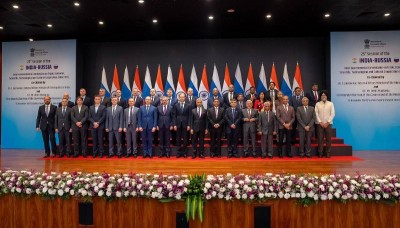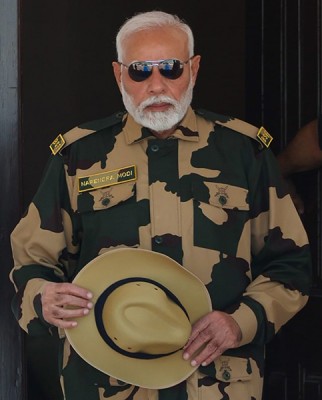
Islamist Recruitment: Intensifying Efforts
In one significant effort to tackle the challenge of online recruitment, a July 21, 2016, report disclosed that the Kolkata Police had decided to recruit around 100 software and networking experts to its Special Task Force (STF). The move was initiated after Kolkata Police Commissioner Rajeev Kumar stressed the need for better monitoring of social networking sites such as Facebook and Twitter, where the Police believe terror groups "spot" potential recruits. A source added, "The idea is to stop these youths before they get radicalized. Among the terror groups, the Islamic State (IS)/ Daesh has a specific formula. They want to attach themselves to young men who have problems and are looking for something to give them a structure in their life."
In December, 2014, the National Investigation Agency (NIA) arrested Mehdi Masroor Biswas, a native of West Bengal, an electrical engineer posted in Bangalore, as he was tweeting to recruit for the IS. Police recovered some 122,000 Twitter messages with over 18,000 followers on his Twitter handle.
An unconfirmed report in January 2016 suggested that Daesh had contacted over 30,000 young techies from India and that some of them may already have grabbed the opportunity offered.
Significantly, Islamist terror entities appear to be working across group lines. Operatives of Indian Mujahideen (IM) and IS, for instance, have been working in tandem for recruitment. In January 2016, the Intelligence Bureau (IB) found chatter on the internet suggesting that Ansar-ut Tawhid fi Bilal al-Hind, an IM splinter, was attempting to carry out strikes in India. Earlier, in August 2014, the group had pledged support to IS and promised to recruit at least 300 Indians. IB officials have been on the trail of brothers Sultan and Shafi Armar who operated various handles on Twitter. Sultan Armar was killed in a US strike in Syria on March 6, 2015, while Shafi Armar continues to run Ansar-ut Tawhid (AuT)'s operations, now under the identity of Janood-ul-Khalifa-e-Hind or the Army of Caliph in India.
Janood-ul-Khalifa-e-Hind has managed to recruit a handful of young men in different parts of the country, and has emerged as a new threat. Investigations by NIA reveal that a financial nexus was involved in the recruitment process. Mudabbir Mushtaq Shaikh, the 'chief' of Janood-ul-Khalifa-e-Hind confessed to having received INR 600,000 from Shafi Armar.
A July 26, 2016 report stated that there have been a total of 54 arrests made in India linked to IS. Sources disclose that the suspects, during interrogation, explained the functioning of their motivators who, through social media and WhatsApp, look for "talent" and after spotting them, carry out indoctrination by sending links to videos of atrocities on Muslims, speeches of Islamist extremists and write-ups to lure them to their violent ideology.
In Pakistan, direct linkages with Daesh and a number of splinters of the Tehrik-e-Taliban Pakistan (TTP), under the umbrella of the Islamic State-Wilayat Khorasan, have been established and constitute a direct kinetic threat to security. Nevertheless, cyber recruitment plays a significant role, even as domestic terrorist formationscontinue to play a role in international terrorism. The blasts at Medina (July 4, 2016), in the month of Ramadan, in Saudi Arabia are a case in point, with direct links to the Lashkar-e-Taiba and its chief, Hafiz Mohammad Saeed. 12 Pakistanis were arrested in connection with the blasts in Medina. The European Parliament's Vice-President, Ryszard Czarneck, in an editorial titled "Wake up call to Anti-terrorism Ayatollahs" as reported on July 11, 2016, observed that the recent terror attacks in Saudi Arabia had signaled the arrival of LeT's "humanitarian" NGO Falah-e-Insaniyat Foundation (FIF) as the source of the Medina attack. The arrests demonstrate FIF's quiet ways of radicalisation of the Pakistani Diaspora, as part of LeT's campaign for a new Islamist world order based on Sharia, Czarneck noted. One of the suicide bombers involved in the attacks was identified as Abdullah Qalzar Khan, a Pakistani national.
Hafiz Saeed's terrorist footprints have long been visible in India, especially in Jammu and Kashmir (J&K). As reported in January 2016, LeT is recruiting "vulnerable young men in Pakistan," as part of a larger conspiracy to wage war against India, especially in the state of J&K, a chargesheet filed by NIA in the Udhampur terrorist attack(August 5, 2015) case stated. On April 26, 2016, Haribhai Parthibhai Chaudhary, India's Minister of State for Home, also mentioned in a written reply to Parliament that LeT was recruiting "vulnerable young men in Pakistan" as part of a larger conspiracy to wage war against India.
Apart from LeT and its affiliates, other terrorist organizations, including Jaish-e-Mohammed (JeM) and Hizbul Mujahideen (HM) have been openly involved in generating funds for jihad and recruiting cadres. A July 5, 2016, report noted that JeM was soliciting funds from various mosques in Karachi (Provincial capital of Sindh) to send jihadists to fight in India and Afghanistan. Video footage showed JeM cadres demanding money from people in name of Kashmir and the jihad in Afghanistan and against Americans. HM has also been involved in a recruitment drive, paying a "monthly salary" to its cadres to fight in Kashmir. INR 35,000 was offered to those willing to join HM by 'poster boy' and 'commander' Burhan Wani, who was killed by Security Forces on July 8, 2016 . Wani's picture with other armed cadres, shot in an orchard, had gone viral on social media in August 2015, and was used by HM as a recruiting tool. According to some reports, Wani's viral images and videos on social media had attracted around 100 Kashmiri youth to HM.
In January 2016, Wilayat Khorasan (Khorasan Province), the IS's branch in the Afghanistan-Pakistan region, released a propaganda video titled, "Cubs of the Caliphate Camp," that showed young boys undergoing training for jihad. Earlier, on December 24, 2015, a report on "Recruitment of Pakistani boys and Afghan refugees by Daesh", circulated by the Punjab (Pakistan) Home Department warned against the potential threat of the global terror network. It claimed that Daesh was spreading its propaganda, particularly through CDs, to win the support of Pakistani youth to its global agenda. The report further stated that Daesh had started recruiting individuals from Pakistan, especially Afghan refugees living in different refugee camps in the Federally Administered Tribal Areas (FATA) at a monthly salary ranging from PKR 30,000 to PKR 50,000.
A May 27, 2016, report on the National Action Plan (NAP, launched in January 2015 to tackle terrorism) noted that banned outfits in Pakistan were still recruiting jihadis who had become a serious internal security threat. "Major banned outfits are still recruiting the students of madrasas to wage jihad in the Indian-Held Kashmir and Afghanistan. Such non-state actors have become very dangerous for Pakistan." In the secret document, consisting of 111 pages, the Counter Terrorism Department (CTD), Punjab, revealed that 32 proscribed organizations with nine splinter groups had now become "a nursery of terrorism in Pakistan." Banned organizations like IS and HuT (Hizb-ut-Tahrir) are also gaining ground by establishing a special wing in Pakistan where their 'commanders' are recruiting militants, the document revealed.
The latest attack on the Holey Artisan café in the Gulshan area of capital city Dhaka on 1-2 July, 2016 demonstrated the power of recent recruitment in Bangladesh. The group of middle-class university students behind the attack, affiliated with Jama'atul Mujahideen Bangladesh (JMB) prompted alarm about the reach of terrorists' recruiting networks and how the group drove affluent young men to such barbarism. Following the attack, Bangladesh has launched a clampdown on social media sites spreading jihadist propaganda, saying the country's young were being radicalised online. "Social media has become a fertile ground for recruiting militants," the head of the telecoms regulator Shahjahan Mahmood stated. One of the attackers, Rohan Imtiaz reportedly posted an appeal on Facebook in 2015 urging all Muslims to become terrorists. Survivors of the café siege narrated how the young attackers seized mobile phones from hostages and forced them to provide their passwords so they could send out photographs of the carnage. The Holey Artisan café attackers also sent out their own photographs as well as images of the ongoing carnage even while it was underway, and these quickly found their way to the Daesh website, as the IS claimed the attack as one of its own.
Earlier, in January, 2015 the Bangladesh security services arrested JMB 'regional commander', Shakhawatul Kabir, a self proclaimed 'IT expert', also claiming affiliation to Daesh. Police disclosed that Kabir had set up a Daesh recruitment cell inside Bangladesh, along with friends, Nazrul Islam, Rabiul Islam and Anwar Hossain. The men planned to carry out a series of bombings, and then use the publicity to draw recruits online.
On July 26, 2016, Tarana Halim, Bangladesh's Minister of State, Post and Telecommunications Division stated that she had discussed the export of more internet bandwidth from Bangladesh to India's northeastern States. The Bangladeshi terrorist formation, JMB, is working its way across the border into the Indian States of West Bengal and Assam, and is also recruiting from these areas. An April, 2016 report stated that, according to the Assam Police, JMB operatives are concentrating mostly on recruiting boys from lower Assam Districts. Subsequently, on May 26, 2016, three JMB 'fresh recruits', Mohammad Mohiruddin Sheikh, Mohammad Mafidul Sheikh and Mohammad Rojob Ali Patowary, were arrested from Chirang District in lower Assam. In case of West Bengal, a May, 30 report suggested that Enamul Mollah, a, JMB operative, helped in recruiting new members and also in spreading the group's agenda by circulating jihadi material and arranging programs of radicalisation.
A July 9, 2016, media report indicated that 10 Bangladeshi youth who had been missing for months and feared to have been recruited by terrorist outfits such as the Harkat-ul-Jihad Islami - Bangladesh (HuJI-BD) and JMB and trained as Daesh modules, were believed to be hiding in West Bengal. The Bangladesh Government has shared their details with Delhi. Consequently, vigil has been intensified at the Indo-Bangladesh border in Malda, Murshidabad and North 24-Parganas Districts.
The terrorists are also exploiting disturbed areas along the Bangladesh-Myanmar border to garner recruits. Intelligence reports in the month of February 2016 noted that 20 terrorist outfits in Bangladesh were trying to recruit documented as well as undocumented Rohingyas living in the Districts of Chittagong, Cox's Bazaar and Bandarban. The terrorist groups named their alliance Hilful Fuzul al Islami al Bangladesh (League of the Virtuous - Bangladesh) to recruit the Rohingyas. This otherwise unknown outfit plotted to blow up over 100 navy and coastguard bases and oil refineries in Chittagong city in 2015.
Daesh has claimed responsibility for 21 attacks against foreigners and minorities in Bangladesh since September 2015, and claimed the presence of "Khilafah Soldiers" in the country in April 2016. Agencies, however, claim that this strategy is more about using propaganda to spread fear than carrying out sophisticated terror attacks. Shaykh Abu Ibrahim al-Hanif, the 'self-styled chief' of Daesh in Bangladesh, is also reportedly radicalising and recruiting prospective jihadis in India, Pakistan and Myanmar.
Further, ABT (Ansarullah Bangla Team) also appears to be succeeding in indoctrinating and recruiting elements among the youth. Its main target group for recruitment is highly-motivated and well-educated university students, especially those familiar with the English language and active on social media. However, ABT also recruits from the poorer and more conservative sections of society as well as from the Islamic political organization Jamaat-e-Islami (JI) and its youth wing, the Islami Chhatra Shibir.
The ABT is also known to have extended its recruitment network to Singapore. Between November 16 and December 1, 2015, Singapore authorities detained 27 Bangladeshi construction workers, connected with ABT on charges of conspiring to carry out terrorist attacks on Bangladesh. The group was trying to recruit Bangladeshi workers in Singapore, to wage jihad against the Bangladeshi Government. The Internal Security Department (ISD) of Singapore recovered a "significant amount" of radical and jihad-related material, such as books and videos containing footage of children being trained in jihadi camps. Additionally, documents with graphic images and instructions detailing how to conduct "silent killings'' using different methods, were recovered.
With terrorism becoming a pronounced international phenomenon, frequent lone-wolf incidents, and an increasing number of terror attacks across the world, the recruitment strategies of terrorist formations demand comprehensive study. The profile, both, of potential terrorists, and of recruitment tools, is undergoing continuous shifts, and state agencies seeking to contain the threat will need extraordinary efforts to keep pace.
Support Our Journalism
We cannot do without you.. your contribution supports unbiased journalism
IBNS is not driven by any ism- not wokeism, not racism, not skewed secularism, not hyper right-wing or left liberal ideals, nor by any hardline religious beliefs or hyper nationalism. We want to serve you good old objective news, as they are. We do not judge or preach. We let people decide for themselves. We only try to present factual and well-sourced news.







